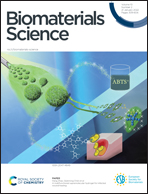Substrate-independent adsorption of nanoparticles as anti-biofilm coatings†
Abstract
Healthcare-associated infections are common causes of morbidity and mortality. Advanced nanotechnology provides a means of overcoming this problem, but it remains challenging to develop universal coating strategies for decorating antimicrobial nanomaterials onto various clinical devices. In this paper, we propose a general silane-based method for immobilizing monolayer metal nanoparticle (NP) arrays onto any type of substrate surface—especially for a diverse range of clinical implantable devices. The surface silanization was achieved simply through the adsorption of N1-(3-trimethoxysilylpropyl)diethylenetriamine (TMS), regardless of the material (polymer, metal, oxide) or morphology (flat, curved, textured) of the substrate, with no need for pretreatment or expensive instrumentation. Monolayers of various nanostructures (Ag, Au, and hollow Au NPs) were then decorated rapidly onto the TMS-treated substrates, thereby further functionalizing their surfaces. In particular, immobilization of the Ag NPs resulted in excellent anti-biofilm efficacy against three clinically life-threatening pathogens: Pseudomonas aeruginosa, Escherichia coli, and Staphylococcus aureus. Sustained release of Ag+ ions led to durable inhibition of bacterial attachment for up to 28 days. Studies with NIH3T3 fibroblasts revealed that the Ag NP arrays displayed no cytotoxicity toward mammalian cells. Overall, this universal coating process appears to be an innovative method for the surface-functionalization of diverse materials and devices employed in the fields of energy, sensing, and medicine—especially to prevent healthcare-associated infections arising from the use of clinical implantable devices in hospitals.



 Please wait while we load your content...
Please wait while we load your content...